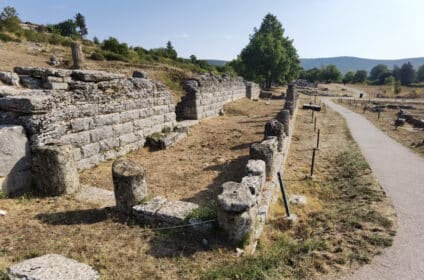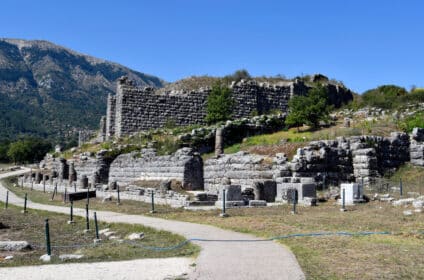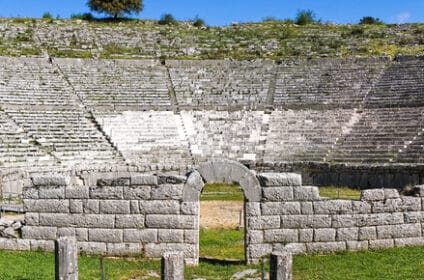- Viewed - 510
Description
The sanctuary of Dodoni, the religious center for northwestern Greece, closely related to the cult of Zeus, father of the gods, lies in the narrow valley east of Tomaros. Dodoni was also known for its famous oracle, traditionally considered the most ancient one in Greece and referred to by Homer in his epics. Herodotus (2.52) relates a myth regarding the establishment of the sanctuary, narrated to him by the sanctuary’s priests on his visit to Dodoni: two black pigeons, the peleiades, flew from Thebes in Egypt, one of them landed in Libya, where the temple of Ammon Zeus was subsequently erected; the other one reached Dodoni, where it sat on an oak tree, Zeus’s sacred tree, and spoke in a human voice, indicating the spot where the god’s oracle was to be built. By observing the rustling of the leaves on the sacred oak tree and the flight of the birds nesting in it the priests interpreted the god’s will. The oracles were based on the murmuring of the waters from the ancient spring and on the sound produced by bronze cauldrons standing on tripods around the sacred tree. According to ancient sources, the priests of the oracle were originally only men, but priestesses, the so-called Peleiades, appear in later times. The priests and priestesses were famous for walking barefoot and for sleeping on the ground so as to be in immediate contact with the earth.
Archaeological evidence suggests that the area was occupied since the Bronze Age. The earliest cult was probably dedicated to the Earth goddess or to another female deity related to fertility. The cult of Zeus, brought to Dodoni by the Selloi, a tribe from Thesprotia, soon became the main cult. Zeus Naios was worshipped together with Dioni, his wife, according to local tradition. Later, the cult of Aphrodite, their daughter, was also introduced, together with that of Themis. Dioni and Themis were worshipped as ‘naian gods’ – that is, gods who shared the same house (synoicous) and temple (synnaioi) as Zeus.
Originally the sanctuary was outdoors, and various ceremonies were performed around the sacred tree (sacred oak or Fagus), in which the divine couple, Zeus and Dioni, resided. Offerings, such as bronze tripods, statuettes, jewelry, and weapons, from southern Greece, reached the sanctuary as early as the eighth century BC, indicating that settlers from Greek cities were colonizing the shores of Epirus. Dodona, however, did not witness the intense building activity of other famous sanctuaries, such as Delphi, Olympia, and Delos, during this period, probably because it was isolated from the rest of Greece and far from all major commercial routes. The sanctuary remained outdoors, and the sacred area of the tree was defined by a kind of enclosure formed by bronze cauldrons.
The first signs of building activity date to the early fourth century BC, when the first small temple of Zeus and three Ionic stoas were erected. The enclosure of the Dodona acropolis, further north, dates to the same period. The sanctuary thrived in the third century BC under King Pyrrhus (297-272 BC), who gave it its monumental character. The rest of the temples and the sanctuary’s most impressive buildings, including the theatre, the bouleuterion, the prytaneum, and the stadium, which hosted the Naian Games held in honor of Zeus, were all erected during this period. The sanctuary was destroyed by the Aetolians in 219 BC, but was soon reconstructed and functioned again until 167 BC when it was destroyed by the Romans. It suffered again in 88 BC under Mithridates VI Eupator, King of Pontus, and his Thracian warriors. The sanctuary was reestablished in the Roman period, although with a different character, and its theatre was converted into an arena, which Emperor Hadrian visited around 132 AD. The oracle and festivities in honor of Zeus continued to attract worshipers until the fourth century BC. Christianity, however, gradually replaced the old religion, Christian basilicas were erected inside the sacred precinct, and the sacred oak was cut down
Administrative Information:
Ephorate of Antiquities of the Prefecture of Ioannina
Τ.Κ. 45500, Dodoni (Prefecture of Ioanina)
Telephone: +30 26510 82287
Fax: 2651001052
Email: efaioa@culture.gr
Tickets:
Special ticket package: Full: €8, Reduced: €4
Valid for: Archaeological Museum of Ioannina, Byzantine Museum of Ioannina, Dodonι
Source: www.odysseus.culture.gr
Ephorate of Antiquities of the Prefecture of Ioannina
Location / Contacts
- Address : Dodoni, Ioanina
- Phone : +30 26510 82287
- Mail : efaioa@culture.gr
- Website : http://www.odysseus.culture.gr





